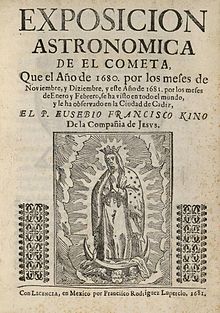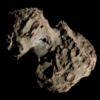astro.wikisort.org - Comet
C/1680 V1, also called the Great Comet of 1680, Kirch's Comet, and Newton's Comet, was the first comet discovered by telescope. It was discovered by Gottfried Kirch and was one of the brightest comets of the seventeenth century.
 The Great Comet of 1680 over Rotterdam as painted by Lieve Verschuier | |
| Discovery | |
|---|---|
| Discovered by | Gottfried Kirch |
| Discovery date | 14 November 1680 |
| Alternative designations | Great Comet of 1680, 1680 V1 |
| Orbital characteristics A | |
| Epoch | 1680-Nov-29.0 2335000.5(?) |
| Observation arc | 125 days |
| Aphelion | 890 au |
| Perihelion | 0.00622 au[1][2] |
| Semi-major axis | 444 au |
| Eccentricity | 0.999986[1][2] |
| Orbital period | ~10,400 yr[3] |
| Inclination | 60.7° |
| Last perihelion | December 18, 1680[1][2] |
| Next perihelion | Unknown |
Overview

The comet was discovered by Gottfried Kirch, a German astronomer, on 14 November 1680 (New Style), in Coburg, and it became one of the brightest comets of the seventeenth century – reputedly visible even in daytime – and was noted for its spectacularly long tail.[4] Passing 0.42 au from Earth on 30 November 1680,[5] it sped around an extremely close perihelion of 0.0062 au (930,000 km; 580,000 mi) on 18 December 1680, reaching its peak brightness on 29 December as it swung outward.[2][5] It was last observed on 19 March 1681.[1] JPL Horizons shows the comet has roughly a barycentric orbital period of 10000 years.[3] As of February 2019[update] the comet was about 257 au (38 billion km) from the Sun.[6]


While the Kirch Comet of 1680–1681 was discovered by – and subsequently named for – Gottfried Kirch, credit must also be given to Eusebio Kino, the Spanish Jesuit priest who charted the comet’s course. During his delayed departure for Mexico, Kino began his observations of the comet in Cádiz in late 1680. Upon his arrival in Mexico City, he published his Exposisión [sic] astronómica de el cometa (Mexico City, 1681) in which he presented his findings. Kino’s Exposisión astronómica is among the earliest scientific treatises published by a European in the New World.[7]

Basil Ringrose was serving under buccaneer Captain Bartholomew Sharpe and made the following observation shortly before raiding the Spanish port city of Coquimbo, Chile:
Friday, November 19th, 1680. This morning about an hour before day we observed a comet to appear a degree N. from the bright in Libra. The body thereof seemed dull, and its tail extended itself 18 or 20 degrees in length, being of a pale colour and pointing directly N.N.W. Our prisoners hereupon reported to us that the Spaniards had seen very strange sights, both at Lima, the capital city of Peru, Guayaquil, and other places, much about the time of our coming into the South Seas.[8]
Although it was undeniably a sungrazing comet, it was probably not part of the Kreutz family.[9] Isaac Newton used the comet to test and verify Kepler's laws.[10] John Flamsteed was the first to propose that the two bright comets of 1680–1681 were the same comet, one travelling inbound to the Sun and the other outbound, and Newton originally disputed this. Newton later changed his mind, and then, with Edmond Halley's help, purloined some of Flamsteed's data to indeed verify this was the case without giving Flamsteed credit.[10]
See also
- Great comet
- Halley's Comet
- Lists of comets
References
- "JPL Small-Body Database Browser: C/1680 V1" (1681-03-19 last obs (Encke : 125-day data arc)). Jet Propulsion Laboratory. Retrieved 26 July 2011.
- "JPL Dastcom Comet Orbital Elements". Archived from the original on 6 September 2008. Retrieved 10 February 2010.
Num Name ... q ... Tp ... C/1680 V1 (1680 V1) ... 0.00622200 ... 16801218.48760
- Horizons output. "Barycentric Osculating Orbital Elements for Comet C/1680 V1 (C/1680 V1)". Solution using the Solar System Barycenter. Ephemeris Type:Elements and Center:@0 (For epoch 1800 orbit period is "PR= 3.8E+06 / 365.25 days" = ~10,400 years)
- Seargent, David A. J. (2008). The Greatest Comets in History: Broom Stars and Celestial Scimitars. Springer Science & Business Media. pp. 112–113. ISBN 9780387095134.
- Donald Yeomans. "Great Comets in History". Jet Propulsion Laboratory/California Institute of Technology (Solar System Dynamics). Retrieved 1 August 2007.
- NASA JPL Horizons ephemeris more accurate position, no plot. Observer Location: @sun
- Bolton, H. E. (1919). Kino's Historical Memoir of the Pimería Alta. Cleveland, Ohio: Arthur H. Clark. OCLC 1730711. Reprint 1948.
- Exquemelin, A. O. (Alexandre Olivier); Stallybrass, William Swan (1992). The buccaneers of America : a true account of the most remarkable assaults committed of late years upon the coast of the West Indies by the Buccaneers of Jamaica and Tortuga, both English and French ... (1684 ed.). Glorieta, N.M.: Rio Grande Press. p. 382. ISBN 978-0-87380-176-8. Retrieved 5 April 2021.
- Tony Hoffman. "A SOHO and Sungrazing Comet FAQ". Archived from the original on 5 August 2012. Retrieved 6 February 2006.
- Jardine, Lisa (15 March 2013). "A Point of View: Crowd-sourcing comets". Magazine. BBC News. Retrieved 20 May 2013.
External links
- The Great Comet of 1680 Over Rotterdam (APOD 28 October 2013)
На других языках
[de] C/1680 V1
C/1680 V1 ist ein Komet, der um den Jahreswechsel 1680/1681 mit dem bloßen Auge gesehen werden konnte, möglicherweise auch am Tage. Er wird aufgrund seiner außerordentlichen Helligkeit zu den „Großen Kometen“ gezählt.- [en] Great Comet of 1680
[es] Cometa de 1680
El gran cometa de 1680, cometa Kirch o cometa de Newton, catalogado actualmente como C/1680 V1, es uno de los más famosos de los últimos cuatro siglos, si ha de juzgarse por los numerosos escritos que suscitó, y apareció a mediados de noviembre de dicho año, cuando el 14 de noviembre lo descubrió el astrónomo alemán Gottfried Kirch.[ru] Большая комета 1680 года
Большая комета 1680 года или Комета Кирха, а также Комета Ньютона (официальное обозначение C/1680 V1) считается первой кометой, обнаруженной при помощи телескопа. Открыта германским астрономом Готфридом Кирхом 14 ноября 1680 года по юлианскому календарю. Стала одной из самых ярких комет XVII века. Была видимой невооружённым глазом даже днём и отличалась длинным хвостом[1]. Пролетела на минимальном расстоянии 0,42 а. е. от Земли 30 ноября 1680 года. Прошла перигелий 18 декабря 1680 года на расстоянии 0,006222 а. е. (930 000 км) от центра Солнца (или 230 тыс. км от поверхности Солнца). Достигла максимальной яркости 29 декабря, после чего яркость начала уменьшаться[2][3]. Последний раз наблюдалась 19 марта 1681 года. По состоянию на 2012 год комета находилась в 253 а. е. от Солнца.Другой контент может иметь иную лицензию. Перед использованием материалов сайта WikiSort.org внимательно изучите правила лицензирования конкретных элементов наполнения сайта.
WikiSort.org - проект по пересортировке и дополнению контента Википедии

